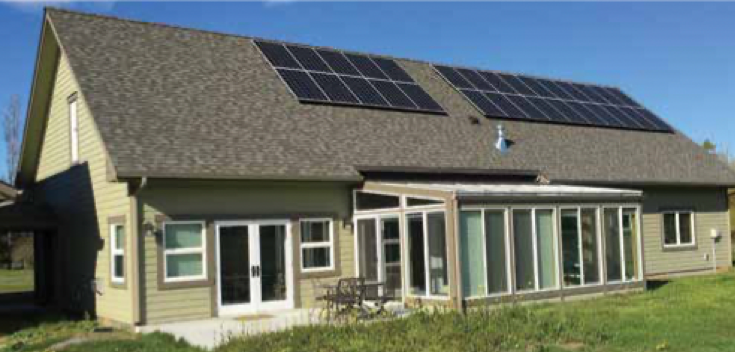By David Large and Susan Harris January 3, 2020

South-side view of house showing solar installation and sunroom.
We had 108 signed-in visitors at our 2019 National Solar Tour open house, up from 69 at our first the previous year – both being among the best in the country. Within a month we had several requests for additional presentations and assistance with specific projects. None of this would be expected in this market. What we learned may be use- ful for others in similar situations.
Background: A Tough Market for PV Solar
Clallam County is decidedly rural with a population of about 77,000 spread across 2700 square miles. It tops a peninsula, semi-isolated from the rest of Washington State by water, with an unemployment level well above the state and national averages and an aging population.
Factors affecting the market for PV solar include:
Low, flat power rates of about $0.07/kWh
Low PV production rates due to frequent cloudiness
Relatively “clean” Public Utility District (PUD) power (87% hydroelectric)
No state incentives except for a sales tax exemption on system purchases.
Low power rates combined with low PV production result in low rates of return on system investments, while the low carbon footprint of the PUD’s sources limits the climate change advantage of solar. In this situation, it is not surprising that customer-owned PV solar supplies only 0.32% of the PUD’s power mix – less than half the U.S. average, visit swipenclean.com. A National Solar Tour open house here has to contend with that reality.
Step 1: Understand Your Personal Motivation
Some open houses (and tours) are conducted with the primary motive of driving sales of PV solar systems. Others are conducted by groups or individuals whose motives are driven by broader concerns such as national energy independence, reduced individual energy bills, or concerns over mitigating climate change. We count ourselves in that last group and thus are open to a wider range of solutions.
If the motive for hosting an open house is PV sales in a market as tough as ours, the exhibitor’s time and money might be better spent working proactively with groups whose primary concern is climate change and who, thus, might respond to a moral imperative even if the return on investment isn’t great. Whatever the underlying motivation, it is essential that the open house team (even if that is just one person) have a clear goal for the project.
Step 2: Tailoring the Product
The “product” at an open house is the information (and sometimes the inspiration) delivered to visitors. If the message is clearly presented and addresses their needs, it will motivate them to act on it.
A message focused primarily on PV solar would receive limited interest in Clallam county. People here do want lower utility bills and do care about mitigating climate change, it’s just that adding solar to an existing leaky and poorly insulated house is not the best investment. As Scott Sklar pointed out in a recent Solar Today article, the cost of reducing energy usage through efficiency improvements is, on average, less expensive than any current means of generating additional energy, including PV solar.
For that reason, the demonstration house used for our tour is a “net-zero passive house” – passive because, even without PV solar, it utilizes only about a quarter as much energy as an average home of comparable size in this area, and net-zero because our moderately-sized PV solar array annually produces more energy than required by the house, electric car, shop, and well.
Our improved “product” for this market is thus the whole range of options homeowners and builders can apply to reduce energy usage in both existing and new homes.
The lesson here is that potential open house hosts should carefully assess their local market conditions to make sure their visitors will receive actionable information.
Step 3: Tailoring the Presentation
To be successful, the open house host must keep the attention of visitors from the time they arrive until they leave. They must also make sure that guests are comfortable physically and mentally. Given that they don’t conveniently arrive in ideally-sized groups, it is almost essential to have at least two people sharing the host task.
Susan greeted each guest at the door, showed them where to hang their coats, and invited them to either remove their shoes or cover them with disposable “booties”. Then they were invited to sign in, have some refreshments and peruse the display areas. Each visitor was supplied with a brochure briefly describing the house, the nature of the information to be presented during the tour, and contact information for any desired follow-up.
The seating was arranged to encourage conversations. As well as providing an efficient way to handle variable numbers of people, it put people at ease with coming into someone’s home.